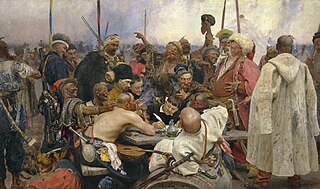 W
WArmorial of Little Russia is an armorial of noble Ukrainian families from the Russian Empire. It was published in 1914, in Saint Petersburg, by the nobility of Chernigov Governorate. The Armorial was edited by Russian historian Vladislav Lukomski and Ukrainian historian Vadym Modzalevski, and illustrated by Ukrainian artist Heorhiy Narbut. It contains images and description of 700 coats of arms of Ukrainian, predominantly Cossack, families.
 W
WBaidak was a wooden sailing ship, similar to a cog. It had a flush-laid flat bottom approximately 3–4 metres wide, which narrowed to tapered ends, and one 5 metre mast. Measuring approximately 15–20 metres in length, a baidak could carry a load of approximately 200 tons. It could be operated by oars or sail.
 W
WA chaika was a wooden boat that could have a mast and sail, a type of galley, used in early modern warfare and cargo transport by the:
 W
WA chokha is a woolen coat with a high neck that is part of the traditional male dress of the peoples of the Caucasus.
 W
WThe Don Cossack Choir Serge Jaroff was a men's chorus of exiled Cossacks founded in 1921 by Serge Jaroff and conducted for almost sixty years by him.
 W
WGazyr, was an implement to hold a rifle charge: a tube with a bullet and a measure of gunpowder or a paper cartridge. They were carried in gazyr bags or in rows of small pockets on the breast. Later gazyr pockets has become a distinctive element of national dress of the peoples of Caucasus, such as Georgian chokha.
 W
WKozachok is a traditional Ukrainian folk dance originating with the Cossacks in the 16th century. In the 17th and 18th centuries it was performed throughout contemporary Ukraine and also in the noble courts of Europe. It is a fast, linear, couple-dance in 24, typically in a constantly increasing tempo and of an improvisatory character, typically in a minor key in Ukraine, and in a major key in Russia. The woman leads and the man follows, imitating her figures – she signals movement changes by hand clapping. In the 17th century, kozachok became fashionable in court music in Europe.
 W
WKuban Cossack Chorus is one of the leading Folkloric ensembles in Russia. Its repertoire and performances reflect the songs, dances and folklore of the Kuban Cossacks.
 W
WKhokhol or oseledets is the stereotypical Ukrainian cossack style of haircut that features a long lock of hair left on the otherwise completely shaved head, commonly sprouting from the top or the front of an otherwise closely shaven head. It is commonly used as an ethnic slur for Ukrainians.
 W
WStanitsa is a village inside a Cossack host (viysko). Stanitsas were the primary unit of Cossack hosts. Stanitsas were Cossack military settlements.